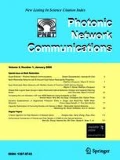Abstract
We introduce an all-optical WDM packet communication network that performs wavelength bypassing at the routers. Packets that arrive at a wavelength (optical cross-connect) router at designated wavelengths are switched by the router without having their headers examined. Thus, the processing element of the router is bypassed by such packets. For packet traffic that uses wavelengths that do not bypass a switch, the headers of such packets are examined to determine if this switch is the destination for the flow. If latter is the case, the packet is removed. Otherwise, the packet is switched to a pre-determined output without incurring (network internal) queueing delays. We study a ring network with routers that employ such a WDM bypassing scheme. We present methods to construct wavelength graphs that define the bypassing pattern employed by the routers to guide the traffic flows distributed at each given wavelength. Performance is measured in terms of the network throughput and the average processing path length (i.e., the average number of switches not being bypassed). For a fixed total processing capacity, we show that a WDM bypassing ring network provides a higher throughput level than that exhibited by a non-bypassing ring network, using the same value of total link capacity. By using WDM bypassing, the average processing path length (and thus the packet latency) is reduced. We study a multitude of network loading configurations, corresponding to distinct traffic matrices and client-server scenarios. Higher throughput levels are obtained for network configurations driven by non-uniform traffic matrices. The demonstrated advantages of WDM bypassing methods shown here for WDM ring networks are also applicable to more general network topological layouts.
Similar content being viewed by others
References
J. Drake, A review of the four major SONET/SDH rings, Proc. of IEEE ICC'93, vol. 2, (Geneva, Switzerland, May 1993), pp. 878–884.
Y. Ofek, Overview of the MetaRing architecture, Computer Networks and ISDN Systems, vol. 26, no. 6-8, (March 1994), pp. 817–829.
K. Imai, T. Ito, H. Kasahara, N. Morita, ATMR: asynchronous transfer mode ring protocol, Computer Networks and ISDN Systems, vol. 26, no. 6-8, (March 1994), pp. 785–798.
I. Rubin, J. Ling, Survivable all-optical cross-connect meshedring communications networks, Proc. of SPIE, vol. 3228, (1997), pp. 280–291.
I. Rubin, H.-K. Hua, An all-optical wavelength-division meshed-ring packet-switching network, Proc. IEEE INFOCOM'95, vol. 3, (Boston, MA, April 1995), pp. 969–976.
I. Rubin, H.-K. Hua, SMARTNet: An all-optical wavelengthdivision meshed-ring packet-switching network, Proc. of IEEE GLOBECOM'95, vol. 3, (Singapore, Nov./Dec. 1995), pp. 1756–1760.
A. L. Chiu, E. H. Modiano, Traffic grooming algorithms for reducing electronic multiplexing costs inWDMring networks, IEEE Journal of Lightwave Technology, vol. 18, no. 1, (2000), pp. 2–12.
I. Cidon, Y. Ofek, MetaRing—a full-duplex ring with fairness and spatial reuse, IEEE Transaction on Communications, vol. 41, no. 9 (Jan. 1993), pp. 110–120.
M. A. Marsan, A. Fumagalli, E. Leonardi, F. Neri, R-daisy: an all-optical packet network, Proc. of SPIE, vol. 2450, (1995), pp. 452–463.
I. Chlamtac, A. Fumagalli, L. G. Kazovsky, P. T. Poggiolini, A multi-gbit/s WDM optical packet network with physical ring topology and multi-subcarrier header encoding, Proc. of ECOC'93, vol. 2, (Montreaux, Switzerland, September 1993), pp. 121–124.
I. Chlamtac, et al., CORD: contention resolution by delay lines, IEEE Journal on Selected Areas in Communications, vol. 14, no. 5 June. (1996), pp. 1014–1029.
Author information
Authors and Affiliations
Rights and permissions
About this article
Cite this article
Rubin, I., Ling, J. All-Optical Wavelength-Bypassing Ring Communications Networks. Photonic Network Communications 2, 315–333 (2000). https://doi.org/10.1023/A:1026554213217
Issue Date:
DOI: https://doi.org/10.1023/A:1026554213217




